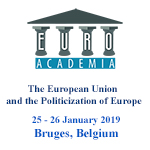Euroacademia Conferences
 Europe Inside-Out: Europe and Europeanness Exposed to Plural Observers (9th Edition) April 24 - 25, 2020
Europe Inside-Out: Europe and Europeanness Exposed to Plural Observers (9th Edition) April 24 - 25, 2020 Identities and Identifications: Politicized Uses of Collective Identities (9th Edition) June 12 - 13, 2020
Identities and Identifications: Politicized Uses of Collective Identities (9th Edition) June 12 - 13, 2020 8th Forum of Critical Studies: Asking Big Questions Again January 24 - 25, 2020
8th Forum of Critical Studies: Asking Big Questions Again January 24 - 25, 2020 Re-Inventing Eastern Europe (7th Edition) December 13 - 14, 2019
Re-Inventing Eastern Europe (7th Edition) December 13 - 14, 2019 The European Union and the Politicization of Europe (8th Edition) October 25 - 26, 2019
The European Union and the Politicization of Europe (8th Edition) October 25 - 26, 2019 Identities and Identifications: Politicized Uses of Collective Identities (8th Edition) June 28 - 29, 2019
Identities and Identifications: Politicized Uses of Collective Identities (8th Edition) June 28 - 29, 2019 The European Union and the Politicization of Europe (7th Edition) January 25 - 26, 2019
The European Union and the Politicization of Europe (7th Edition) January 25 - 26, 2019 7th Forum of Critical Studies: Asking Big Questions Again November 23 - 24, 2018
7th Forum of Critical Studies: Asking Big Questions Again November 23 - 24, 2018 Europe Inside-Out: Europe and Europeanness Exposed to Plural Observers (8th Edition) September 28 - 30, 2018
Europe Inside-Out: Europe and Europeanness Exposed to Plural Observers (8th Edition) September 28 - 30, 2018 Identities and Identifications: Politicized Uses of Collective Identities (7th Edition) June 14 - 15, 2018
Identities and Identifications: Politicized Uses of Collective Identities (7th Edition) June 14 - 15, 2018
“Visability”. Visual Research on Abilities During the Jubilee of Mercy
-
-

-
Presentation speakers
- Francesca Guarino, University of Bologna, Italy
- Download presentation
Abstract:
Nowadays pictures and video have become more and more popular in capturing, communicating and sharing social happenings with a massive impact on social practices and representation of reality. The research job aims to investigate the spreading of digital devices in a religious event when combined with a consistent presence of sickness and disability. In order to analyse this topic, a visual qualitative research study has been developed during the special Jubilee of Mercy that Pope Francesco dedicated to people affected by sickness and disability − Rome, 10-12 of June 2016 − in a perspective of observant participation. More than 2000 pictures from the researcher and the pilgrims from Catholic countries, note fields and about 70 interviews with pilgrims have been collected and then treated and analysed, in two ways. The first kind of analysis leads to an ethnographic reconstruction of those three days with in-depth views on pictures and life stories; the second one leads to define conceptual, thematic areas (as the use of photography in religious event and a sociological research; direct and virtual relationship; organization tools and roles of the special event; sickness and disabilities as care). The results are about a new convergent perspective: that one of “visability”, a neologism born from the research, that links together the word “visibility” and “ability”. In the substance, the research points out how different identity languages can pretend to be as visible as accepted. In that case, the image use seems reducing the difference perceived by disables and sick people about their condition, giving them a chance to participate and express themselves similarly to all the others, adding a welcome claim for their identity, in the past taken in the dark.
-
Related Presentations

The Rise of Ethno-nationalist Populism in Slovenia
- Iztok Šori
- Mojca Pajnik

Yugoslavia on Instagram: The (Re)Construction of a Collective Identity from the Past
- Elisabetta Zurovac
- Giovanni Boccia Artieri

A Liberal Intergovernmental Approach to the Establishment of the European Stability Mechanism
- Madeleine Hosli
- Wen Pan
- Michael Lantmeeters













